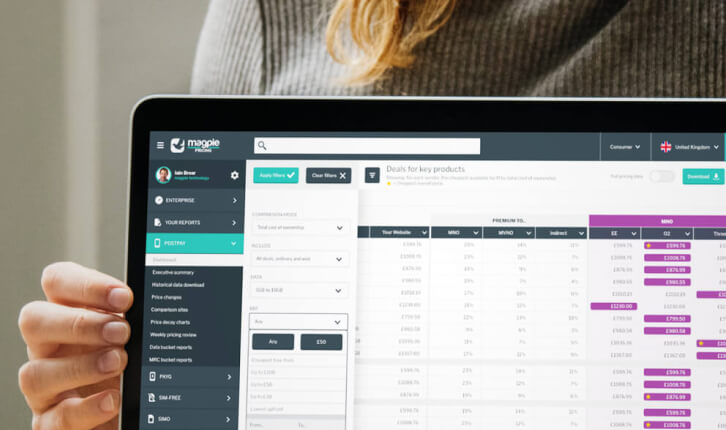Published on: September 29, 2022 | Last updated on: July 22, 2024 |
As an e-commerce business, you’re going to encounter pricing violations at some point.
The digital shelf is vast, and unfortunately some sellers don’t always play by the rules. If the opportunity to undercut your pricing arises, they will take full advantage.
Of course, most online merchants are perfectly compliant with the original requirements of their partners’ terms. However, even just one bad apple could spoil your reputation (and profits).
This article provides you with info on how to deal with pricing violations, so that your company isn’t seriously impacted if and when they occur.

Can prices ever be ‘too low?’ The short answer is yes, and you should watch out for them.
For example, a company may have a MAP pricing policy in place in a compliant way. This means that they’ve agreed the minimum price with retailers at which to sell their products. Should be easy-peasy, right?
Well, the problem is that some resellers take it upon themselves to undercut companies’ MAP pricing. Doing so violates any signed agreements.
Staying on top of pricing violations is your responsibility. Quick action helps preserve market position in the event of prices being violated – either once or repeatedly.
Knowing how to deal with pricing violations from the get-go will help you keep control of your situation and avoid any long-term repercussions.
Here are a few key points to remember:
Whether you’re part of an SME or a large enterprise business, the risks associated with online pricing violations remain the same.
When looking for pricing violations, you should check out small, independent merchants alongside big marketplaces, as the former are more likely to slip through the cracks.
If you’ve encountered a lot of pricing violations recently, you should create a team whose task it is to prevent these from happening. Get them to keep an eye on sellers, products, costs, etc., and find out just how widespread this problem is.
Make sure your team has the right tools as well. Equipping them with software like Magpie DBX ensures that they have everything they need to spot pricing violations as and when they happen.
Once you’ve identified who’s been violating your pricing policy, you can then take proper action. First, contact the offending sellers and obtain their assurance that the violations will no longer continue.
If, however, they are uncontactable or refuse to change their listings despite your objection, you should seek legal advice and work together on a strategy for shutting down this unauthorised trade.
Keep detailed records of sellers violating your price point and any interactions you’ve had with them. Also, make sure you store these records in one place so they’re easy to refer back to.
By doing this, you’re much more likely to identify patterns and repeat offences.
Companies on the digital shelf often have procedures they follow if you report a pricing violation. If, for example, you suspect that an Amazon listing of one of your products has an incredibly low price, your first priority is to let the platform know so they can investigate.
In the US, if you wish to report any pricing violations, contact the Federal Trade Commission (FTC), whose Bureau of Competition enforces the nation’s antitrust laws and works to prevent deceptive and anticompetitive business practices.
Price violations have a detrimental effect on brand positioning. They undermine credibility and jeopardise chances of retaining customers for the future.
Also, they can strain relations with resellers who do follow your recommended pricing strategy, which may result in important contracts disappearing.
It is therefore vital that you address any pricing violations as a matter of urgency; otherwise, you yourself could be held liable and face penalties.
Capable of tracking thousands of price points across the digital shelf, Magpie DBX is well-equipped with competitor pricing intelligence to help you identify and safeguard your business against any violations.
Think of how much time and energy you’ll save: it’s automated, we can monitor all of your resellers/partners, keep track of everything in one place, and alert you when prices drop too low.
Our Stock & Delivery feature can even provide you with information about specific distribution channels, including who manages them and from where. This way, you’re always kept in the loop and able to act if you suspect any funny business.
Magpie could be the software you need to stop pricing violations in their tracks. Get in touch with us and request a free demo now!

There are two kinds of people in this world: those who love data and Excel sheets… and normal people. Or rather, people who might not always have the time or enthusiasm needed to delve into deep CSV files of raw data in order to extract what really matters and translate it into actionable information.
Here at stickee, we believe complex data shouldn’t get in the way of decisions, but instead help you make them. The amount of data you’re generating can seem a little overwhelming at first, but harnessing its power could help you make better choices for your business. Let’s take a look at big data and the impact it can have…

Imagine a shopper has had their eye on one of your products for a really long time. They’ve done all their research, ticked everything off their own internal checklist – they’re ready to go.
Now imagine, for some reason or another, they won’t convert. Can’t bring themselves to do it.
Eventually, they abandon their cart altogether, leaving you (once again!) without a sale.
Checkout abandonment is a common occurrence on the digital shelf, mainly because of the choice customers have nowadays. How are you going to create a sense of certainty with a purchase when they’ve got all this competition staring them in the face?
In this article, we explore what causes checkout abandonment and how you can prevent it from harming your business’s bottom line.

If you run a business, you will have competitors.
And just like you, your competitors are working hard to make their business the best.
Some things will work for them, and some things won’t. They may have already solved problems that you’re currently facing, or maybe they’re gearing up for a big product launch.
But if you’re not keeping a close eye on them, how would you know all this?
In this article, we break down why it’s important to monitor competitors, including how one of our partners solved a crucial problem by monitoring their competition.
Want to learn more about how Magpie DBX can help your business? Get in touch with us and let us show you!




